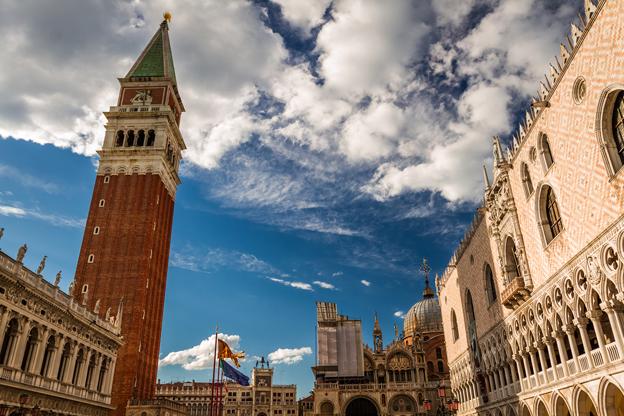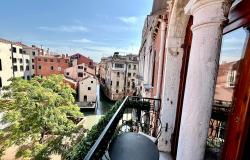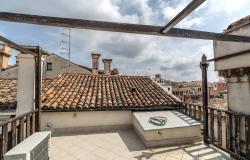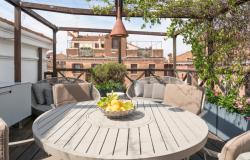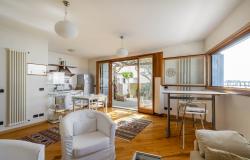A Venice landmark, St. Mark’s Square is the result of a long series of interventions that took place from the 9th century, the time of the first settlement, until the Napoleonic era in the early 19th century. The result? A fusion of different elements and style, from Gothic-Byzantine to Neoclassic, that blend in exquisite harmony in a spectacular space that never fails to captivate for beauty, grandeur and dimensions: St. Mark’s Square measures 175 meters in length from St. Mark’s Basilica to the Napoleonic Wing. The social, political and religious center of Venice, it is the city’s only ‘piazza’ – the others are known as ‘campi’.
St. Mark’s Square – What to Look Out For
Doge’s Palace – one of the square’s most important monuments, it overlooks, with its two identical facades, the Piazzetta and the quay facing the lagoon. The palace was the residence of the Doge, the maximum authority of the former Republic of Venice, and is now open as a museum. A must-see when visiting Venice.
St. Mark’s Basilica – At the eastern end of the Piazza San Marco, adjacent to the Doge's Palace, Venice’s Cathedral, built in 829 to house St. Mark’s relics, is a jewel of Byzantine art, decorated with magnificent mosaics. It has always been a symbol of Venetian wealth and power.
St. Mark’s Campanile – Rebuilt “as it was, where it was” in 1912 after collapsing in 1902, it stands on a corner of the square, near the front of the Basilica. It is almost 99 meters tall. Climb to the top of the Campanile for a truly magnificent view of the city, the lagoon, the Lido and the islands of Giudecca, San Giorgio and Murano.
Bibiloteca Marciana or Libreria Sansoviniana (National Library of St Mark's) – located between the Campanile and the Zecca, it houses one of the greatest classical texts collections in the world. The building, an architectural masterpiece by Sansovino, was built starting in 1537 to house the precious bequest by Cardinal Bressarione of about 1,000 Greek and Latin codexes.
Piazzetta – created in the 12th century, it is an extension of the piazza connecting the south side of St. Mark’s Square to the waterway of the lagoon, and is framed by the tall Column of San Marco, surmounted by the Lion of Venice, and Column of San Todaro (San Teodoro, first patron saint of the city).
Clock Tower (Torre dell’Orologio) – completed in 1499, it is surmounted by two bronze statues known as ‘i Mori’, who strike the hours on a large bell. The building was placed where the clock would be visible from the waters of the lagoon. Stairways inside the building give access to the terrace on the roof, passing the clock mechanism on the way. Visits to the Clock Tower must be booked in advance.
Pavement – as you walk around the square, gaze down to the beautiful paving of trachyte (a volcanic rock) slabs and Istria stone, which substituted the former wooden covering in 1723.
Procuratie Vecchie – the former seat of the Procurators of St. Mark, the highest authorities after the Doge, the ‘old procuracies’, built in the early 16th century, occupy the north side of the piazza. The building’s arcade is lined with shops and restaurants, including the famous Caffè Quadri, dating to 1775.
Napoleonic Wing – at the far end of the square is the building known as the Ala Napoleonica, rebuilt by Napoleon around 1810. Today it houses the Museo Correr, one of the 11 civic museums run by the Fondazione Musei Civici di Venezia, illustrating the art and history of Venice.
Procuratie Nuove – occupying the south side of the Piazza, the ‘new procuracies’ were designed by Jacopo Sansovino in the mid-16th century. Just as for the Procuratie Vecchie, the arcade houses shops and restaurants, including the famous Caffé Florian, said to be the oldest coffee house in continuous operation, established in 1720.
